
The Definitive Guide to Online Customer Reviews
With 90% of customers saying that their buying decisions are influenced by online reviews, it's essential to make them a central part of your ecommerce strategy. Here's how.
It’s essential to make customer reviews a central part of your ecommerce strategy.
As social creatures, humans are hard-wired to respond to social proof and the wisdom of crowds. That’s the psychology behind the effectiveness and rise of online reviews.
In fact, as ecommerce has grown, online reviews have been one of the key tools that build and retain consumer trust. According to Baymard Institute, 95% of users rely on reviews to evaluate or learn more about products. In some cases, users grant more weight to product descriptions in reviews than the brand’s native product description. User reviews are the most utilized part of the product page after images.
This means that reviews have become an expected element of the ecommerce shopping experience. As an ecommerce brand, it’s now essential to include customer reviews as a central part of your strategy.
In this definitive guide to online customer reviews, we will give you all the tools you need to get the most out of your online reviews.
Why Your Ecommerce Site Needs Online Reviews: They Boost Conversions
Social influence is powerful. The percent of people who trust online reviews in their buying decisions is greater than ever. In fact, 84% of shoppers trust online reviews as much as a personal recommendation from friends and family.
Let’s go over some reasons online reviews are important and how they influence conversions.
1. Online reviews are part of the customer journey
We’ve spoken to several ecommerce site managers who don’t allow customers to submit reviews of products. They’ve done this intentionally for many reasons: They fear receiving a negative review, they don’t have enough resources to monitor the reviews, or they just don’t know where to begin. The simple answer for them was to remove the ability for customer-generated reviews altogether. They eliminated the problem by ignoring it.
Unfortunately, by doing this they also eliminated a valuable piece of the customer buying experience.
No matter your industry, having positive online reviews gives you several key advantages that all boost conversions. For example, Seriously Silly Socks (an online sock retailer) was able to drive 60% higher average order value due to reviews. “We encourage reviews by emailing customers after purchase and offering a discount coupon in return for a completed review,” says owner Andrew Gill.
“It’s probably our most important social tool. More important than channels like Facebook because we get more direct communication with customers and we get real feedback about our products and our service.”
The following is an example that we see frequently while evaluating customer online shopping journeys. As you can see, reviews are an important part of that journey to purchase. If you don’t offer reviews, your customers can’t complete their journey.

2. Reviews make your site more visible
Obviously you want your site to be as visible as possible in organic search. Online reviews can actually help with that. When search engines like Google and Bing categorize your site, they place a value on original content, but product pages are traditionally hard to rank due to light content.
According to online review platform Yotpo, reviews offer SEO benefits by providing a stream of fresh content, helping your rank for long-tail keywords, and boosting social SEO. This graph shows the change in organic rankings due to reviews.
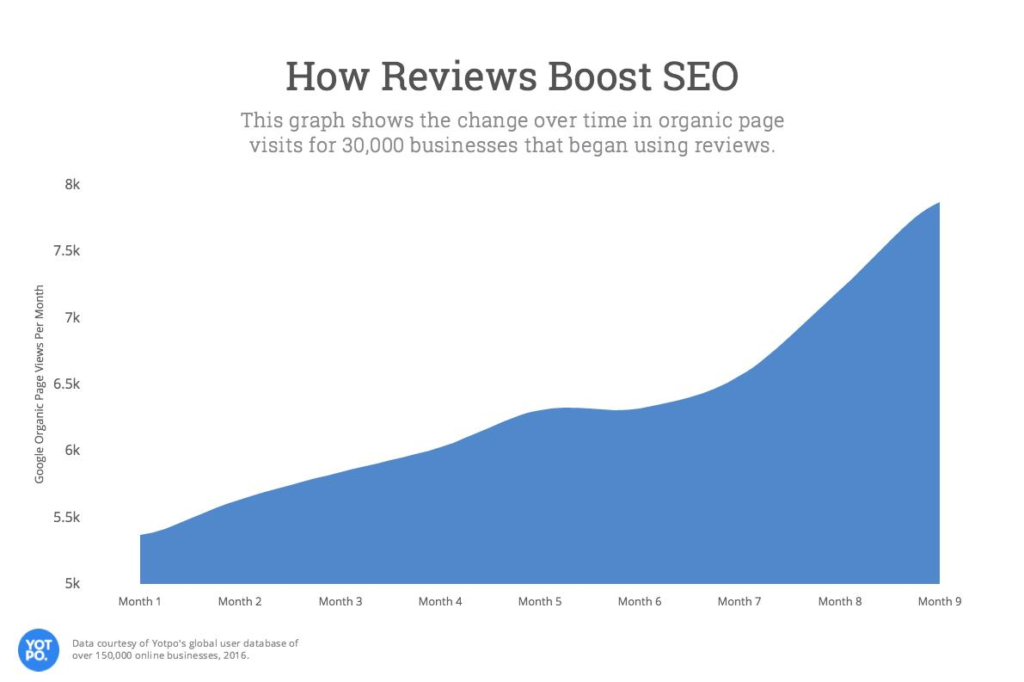
3. Online reviews build trust with shoppers
Trust is a critical component of a customer’s shopping experience. If they don’t trust your brand, they won’t take the plunge of making a purchase.
It’s a simple equation: Few people will buy from a business with less than 3/5 stars. Most people prefer to shop at stores that have mostly 4/5 stars. A slim group of people will only buy from stores with perfect scores. Therefore, better ratings mean more trust.

4. Online reviews help you communicate with customers
Online reviews give you a forum to communicate with your customers. You can respond to their praises and their complaints. This gives you a chance to rectify problems and show other customers that you care about their experience.
Better communication through reviews can create more reviews, as well. For example, MedQuest was able to significantly improve its ratings and review volume by responding faster to both negative and positive responses. Their review volume soared on Facebook by 163% and on Google by 23%.

5. Online reviews have an undeniable impact on sales
This is the biggest benefit and the one you probably care about the most.
A study by the Harvard Business School learned that online reviews have a real effect on your bottom line. A one-star improvement leads to a 5% to 9% boost on sales in the short term. Even a small improvement can have a massive impact.
In a 2016 study, Revoo discovered that online reviews drive an average of 18% sales uplift by affecting conversion rates, order sizes, and repeat orders. And a Berkeley study found that just a half-star improvement for a restaurant made it 30% to 49% more likely to fill up during its busy hours.
Additionally, one report found that products with more than five reviews have a significantly higher conversion rate than those with no reviews. “As products begin displaying reviews, conversion rates escalate rapidly,” the report notes. “The purchase likelihood for a product with five reviews is 270% greater than the purchase likelihood of a product with no reviews.”
Furthermore, the report also found a relationship between conversion rate and price: As a product’s price increases, so does the importance of reviews. “When reviews were displayed for a lower-priced product, the conversion rate increased 19%. However, for a higher-priced product, the conversion rate increased 380%.”

The pattern here is clear: If people see lots of positive online reviews, they are more likely to make a purchase, spend more money, and make future purchases.
Where to Set Up Online Reviews on Your Ecommerce Site
Customers expect to see reviews at the product level, so every product page should have the functionality to leave and read comments. These typically sit lower on the page, beneath the product image, description, details, and add-to-cart button.

The following example captures many of the traditional elements of a customer review section. Your page layout may need to be tested to ensure that the placement of comments flows appropriately with your customer’s unique journey.
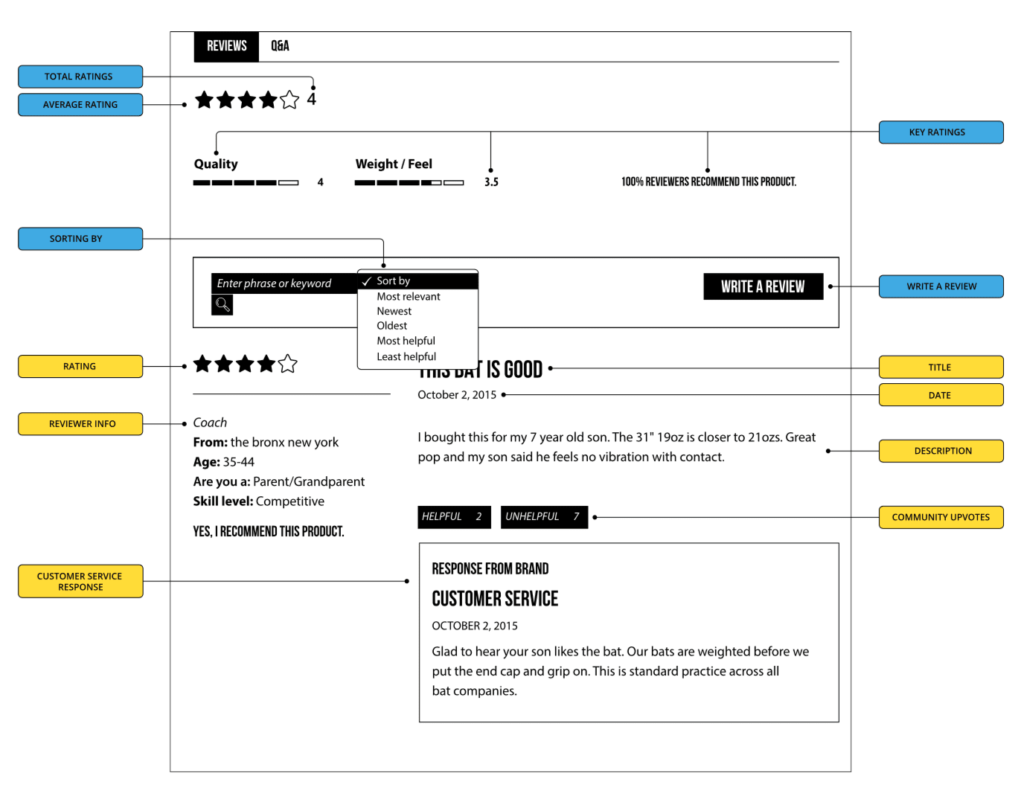
Depending on your unique audience, it may be appropriate to add additional details to the reviewer’s information to lend credibility to the review. This helps customers accept a reviewer is a real person and not a clever ploy by the retailer.
These additional details may include using their real first names instead of usernames or nicknames. This can be done by connecting their review to their account on your site or by requiring customers to leave a review tied to a social media account.
Other additional reviewer details may include:
- Profile picture or an avatar
- “Customer/member since” date
- Number of reviews written for your company
- Reviewer qualifications, such as age, description, skill level/experience, etc.
- Description of pros & cons or likes & dislikes
- Explanations of how the product has performed for them personally
The following review widget is a good example of this. It includes lots of detailed information about the reviewer, such as their username, profile picture, date of stay, trip type, and review date. It screams authenticity.

Ecommerce Online Review Platforms
There are a variety of customer review systems out there, each with different pros and cons.
Many of the popular ecommerce platforms like Shopify, Woocommerce, Magento, and others offer built-in product review apps or allow for custom add-ons. So the technical barrier to enable reviews on these platforms is low.
Depending on your platform, you may need to implement a third-party review system. Here are some options:
We recommend using a review system that allows you to subscribe to their software as a service, rather than developing code to add to your site. This keeps all the work of maintaining code, upgrading features, and security/privacy concerns in the vendor’s court instead of yours.
These services manage the process of capturing, moderating, and displaying reviews and questions from customers. They also automatically send out review request emails to customers after they’ve purchased a product from your site. This feature alone will significantly and organically boost reviews, which can be requested for your site or for specific products.
For custom or proprietary ecommerce systems, contact your web design and development teams to discuss your options. If you need help, we’d be happy to recommend our favorites that we have seen work best to increase engagement and online sales.
How to Get Online Reviews From Your Ecommerce Customers
“Okay, okay,” you’re probably thinking. “I get that reviews are important. So how do I get them?”
Once you’ve enabled customers to leave reviews, the reviews will start pouring in, right? Wrong.
Studies show that only about 5% of customers write reviews. Many times, customers will only leave reviews if they had an exceptionally positive or exceptionally negative experience. Getting good, relevant feedback doesn’t have to just be the exceptional extremes.
So how do you get more of your customers to leave reviews on your site?
It seems pretty basic, but the most effective strategy to get online reviews is to simply ask for them. Post-purchase customer outreach can be an effective method to remind your customers that their feedback matters. Their feedback will help others decide to make a purchase as well as help your company to improve future product development.
How do you ask a customer for a review?
Time the request appropriately
Send an email to every customer requesting a review. The request should occur after the customer has had a reasonable amount of time to receive the product and provide an informed opinion. You don’t have to be long-winded here. Keep things short and simple.

Seed the review with suggestions
Provide suggested topics for the reviewer to write about in their review. Use positive action words to encourage highlighting the strengths of the product. E.g. “Describe your increased productivity after buying this product.”
That said, do not instruct them on what to write. If you give your customers explicit copy for them to post, they will either a) ignore you, b) write something different just to spite you, or c) mention your instructions in the review itself, which would obliterate the trust and authenticity you’re trying to build with online reviews in the first place.
Offer incentives (if possible)
Whenever possible (and not prohibited by law), providing a small discount on a future purchase in exchange for a review can be an effective way to incentivize the customer into action.
Provide a link to a customized landing page
Make the path for the customer to complete their task as simple as possible. In this case, provide them with a link to a page that has already been set up with a list of their recent purchases and open text fields to complete the reviews.
If allowed, embed a single sign-on action into the link or any other method that allows an automatic login to their account. Make the amount of effort for your customers as low as possible.
There’s no perfect template for this email but here is an example that ties all of these elements together:
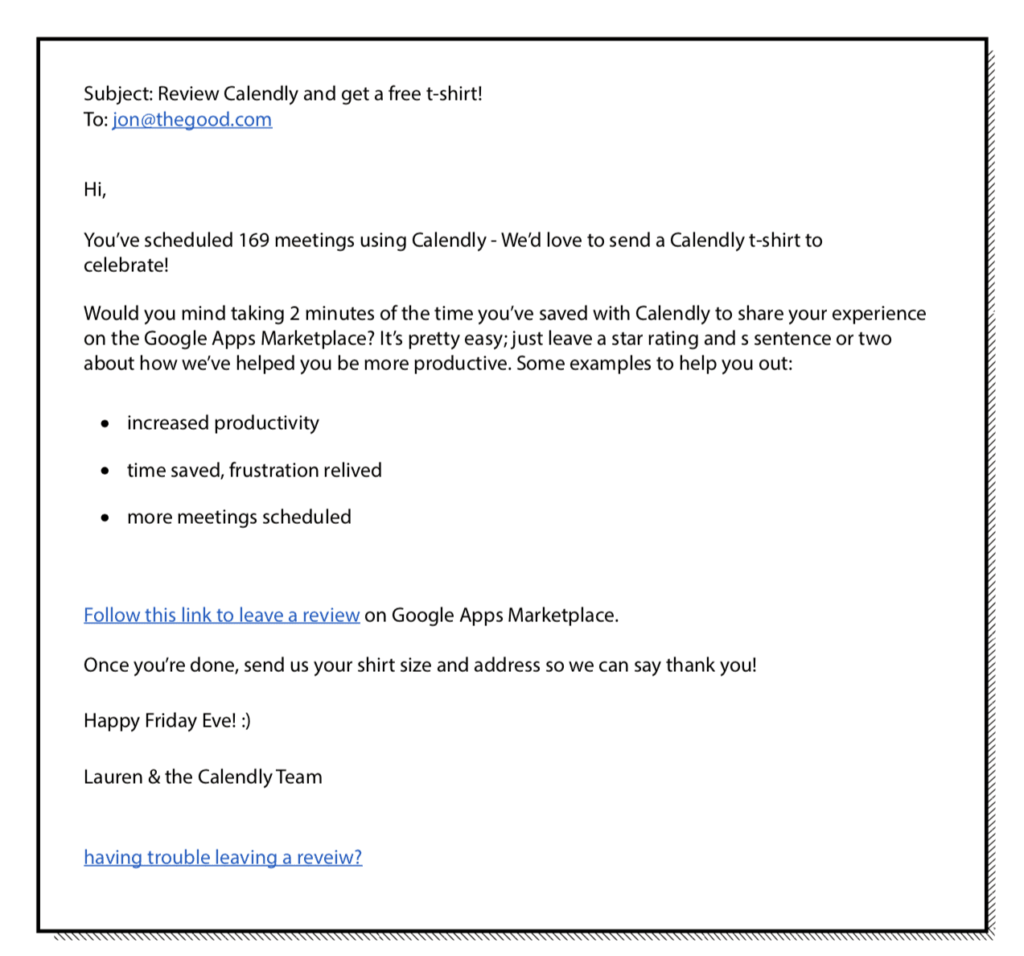
Don’t post your own fake reviews
Do the steps above seem daunting to you? Are you tempted to bypass the effort by creating a set of fake users to leave fake reviews that make the products more appealing?
Our answer to you is simple: Do not post fake reviews. Savvy customers are able to sniff out the obvious fraudulent reviews quite easily. In this way, disingenuous companies that use fake reviews are often exposed. News organizations have published reports of companies who use fake reviews and even provide lists of how to spot a fake review. Simply put, the risk is not worth the reward.
How to Address Negative Online Reviews
Now that you have reviews up and running, it’s important to ensure that you have customer service staff monitoring the reviews and responding as needed. Many of the ecommerce platform apps have automatic notifications sent to your staff when a new comment arrives so they can be prompted to reply.
Almost certainly at some point, a negative review will appear on your site. Don’t panic!
First, it’s important to understand that negative reviews aren’t the end of the world. It would be great if all of your customers had only positive things to say, but that’s not reasonable. The occasional one-star review won’t be the end of your business. In fact, a few poor reviews can actually be beneficial.
You see, the customers want to trust the brands they buy from. Research from Edelman found that 81% of consumers want to trust a brand prior to making a purchase, and 70% indicate trusting a brand is more important now than ever before.
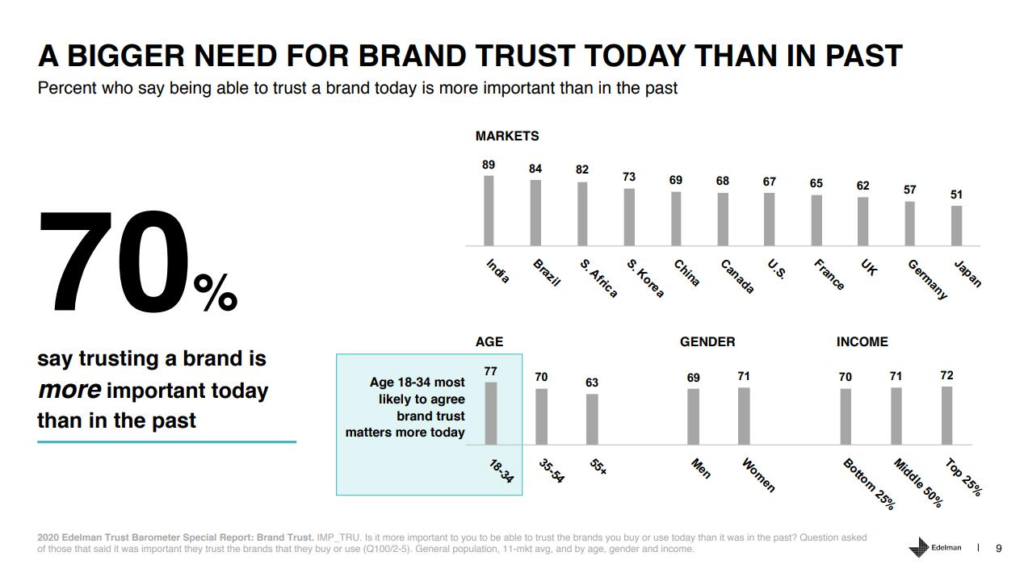
In order to earn their trust, you have to be transparent. And that means displaying all types of feedback, even the kind of feedback that isn’t so flattering. When a shopper sees negative feedback, they see you as an honest brand that isn’t trying to hide anything. In turn, this makes them more trusting of the other reviews and your own words.
That’s good in theory, but does it really produce more sales? Actually, yes! A Northwestern University study found that shoppers are more likely to purchase a product when there are some negative reviews present.
In fact, researchers learned that there’s no benefit in chasing a five-star review. Purchase probability peaks between 4.2 and 4.5 stars (with some variation based on product categories). If the average rating exceeds 4.5, the likelihood of purchase actually drops.
Here’s what the purchase probability for salon hair care products looks like.
What causes this? Basically, consumers don’t trust products that have perfect scores. They assume a perfect five-star rating and miles of only-positive reviews mean something fishy is going on. They become skeptical and distrustful. They may even jump to the conclusion that you are deliberately filtering out the bad reviews to trick them.
Furthermore, research shows that 85% of customers seek out negative reviews to help them make informed decisions. A third of shoppers say that a negative perspective is either an “important” or “very important” decision-making factor.
How do negative online reviews influence their decisions?
- Shoppers look for reasons to eliminate products from their search. When they are comparing multiple similar items together, they need a way to separate them to choose the one that’s right for them.
- Shoppers look for bad reviews to understand product limitations. If a poor review says a product is “not as waterproof as they claim,” a shopper may want to know that before they take the product near water.
- Shoppers want to know the worst case scenario. If a reviewer claims the product isn’t’ waterproof, the shopper knows to keep it away from water. Now they have knowledge to protect the product, which makes them more comfortable.
Okay – So what, if anything, should you do about negative online reviews?
1. Don’t hide bad reviews
Avoid the temptation to filter out your negative reviews. Let them sit openly on your website as a layer of authenticity and transparency for your customers.
Furthermore, give your shoppers the ability to filter your reviews by rating. This way shoppers can look at all of your one-star ratings at once if they wanted. Notice how Aerie lets users filter by one-star rating, which reveals the poor reviews.
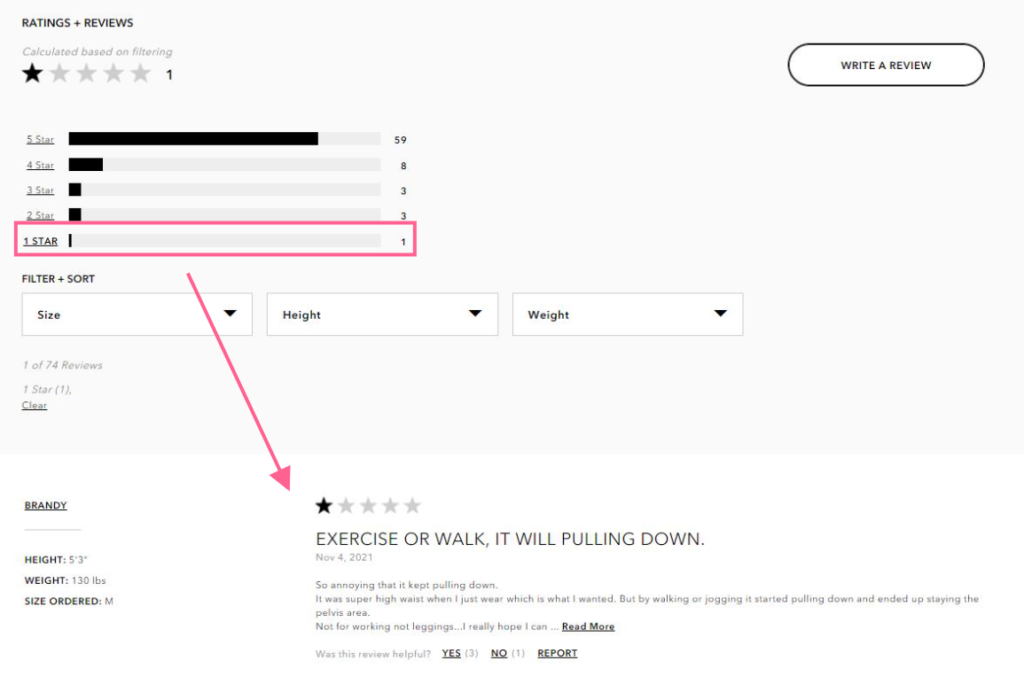
2. Respond promptly, politely, and publicly
A poor review is an opportunity to improve a bad situation and possibly repair the relationship with your customer. Even if the customer is still unsatisfied, future customers will appreciate your reply.
Take the high road in the response because there’s no sense in engaging in a debate with your customer about your product. Do NOT use a generic, copy/paste response. Personalize your message to the reviewer’s specific claims.
Here are some ways to handle negative reviews, whether they’re true or false:
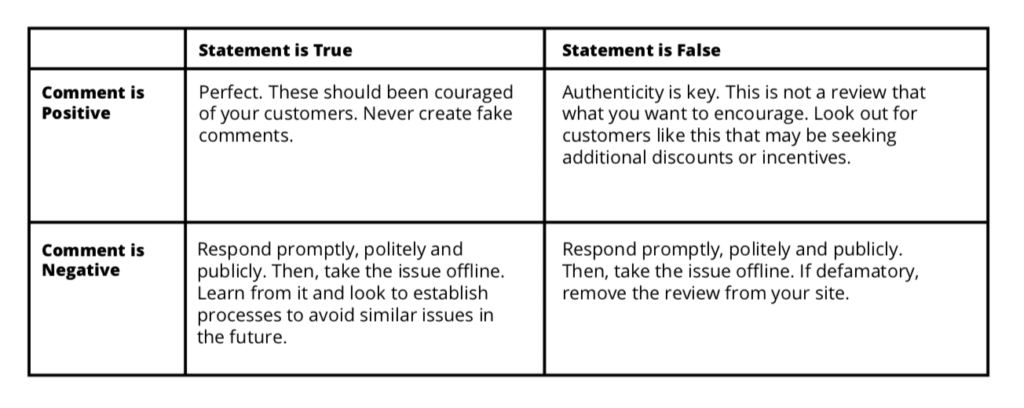
Negative review where the statement is true:
This customer has posted a comment about the product which, although maybe technically accurate, is highly negative. An example of this is shown in the example below. A particular product sent to a customer was found faulty so the customer expressed his displeasure in the review. It turns out that this comment helped the company to identify a supplier defect and issued a recall.
As this case demonstrates, the best response is to have a customer service representative investigate and respond promptly, politely, and publicly then take the conversation offline for resolution. Sometimes it can be appropriate to turn the negative comments around by highlighting the strengths of the product.
For example, a negative comment about the oversized fit of a shirt that you sell can be turned into a selling point about the quality of the materials that don’t shrink when washed. Naturally, this should be coupled with an attempt to resolve the issue, like offering to return the customer’s shirt for an appropriately fitting size.
Negative review where the statement is false:
A customer has posted a new review complaining about a pair of running shoes they recently purchased that did not increase their fitness as the product imagery made it appear they could do. This customer is livid about the promises made to them by the company and vows to never purchase from them again. This review is both highly inaccurate and negative.
The best response is to have a customer service representative respond promptly, politely, and publicly by taking the high road. You know this statement is untrue but there is no need to engage in a debate or escalate the issue any further. If the comment is vulgar or defamatory then you can remove the review completely.
Not all reviews are negative and not all positive reviews are true. Here’s a takeaway reference guide to help you decide how to address comments.
3. Resolve the issue offline
Once future review readers see that you haven’t ignored the issue and have responded professionally, encourage the conversation to continue with customer service directly. Then ensure that the issue has been completely resolved.
4. Learn from the issue
Sometimes a negative review indicates an isolated issue. There’s not much you can do about it except to make it right for that one customer. But in other cases, a poor review might indicate a larger problem that deserves correction. They can help you identify issues with your products or services that you may not have been aware of. This is invaluable feedback they give you an opportunity to improve your business.
For instance, if a reviewer complains that a product was difficult to assemble because the pieces didn’t fit properly, you could bring that issue to your manufacturer and work to find a better way to produce or quality control the product.
If the feedback is helpful, share it with employees as learning opportunities and distribute feedback to the appropriate teams (e.g. product feedback to the product development team).
How The Good Can Help You
At The Good, we see customer reviews as a tremendous opportunity for companies to aid prospective customers on their journey by leveraging social proof. Every brand is different, but our data-backed processes and intelligent experiments are designed to create a solution that will resonate with your customers and rescue more sales.
Learn more on your own by reading our book, “Opting In To Optimization.” You’ll learn a set of principles to help you and build a sustainable, thriving business that can weather unexpected economic storms.
Want specific help with your ecommerce business? As a part of our Conversion Growth Program™, we form a plan to add and improve customer reviews.

About the Author
Jon MacDonald
Jon MacDonald is founder and President of The Good, a digital experience optimization firm that has achieved results for some of the largest companies including Adobe, Nike, Xerox, Verizon, Intel and more. Jon regularly contributes to publications like Entrepreneur and Inc.